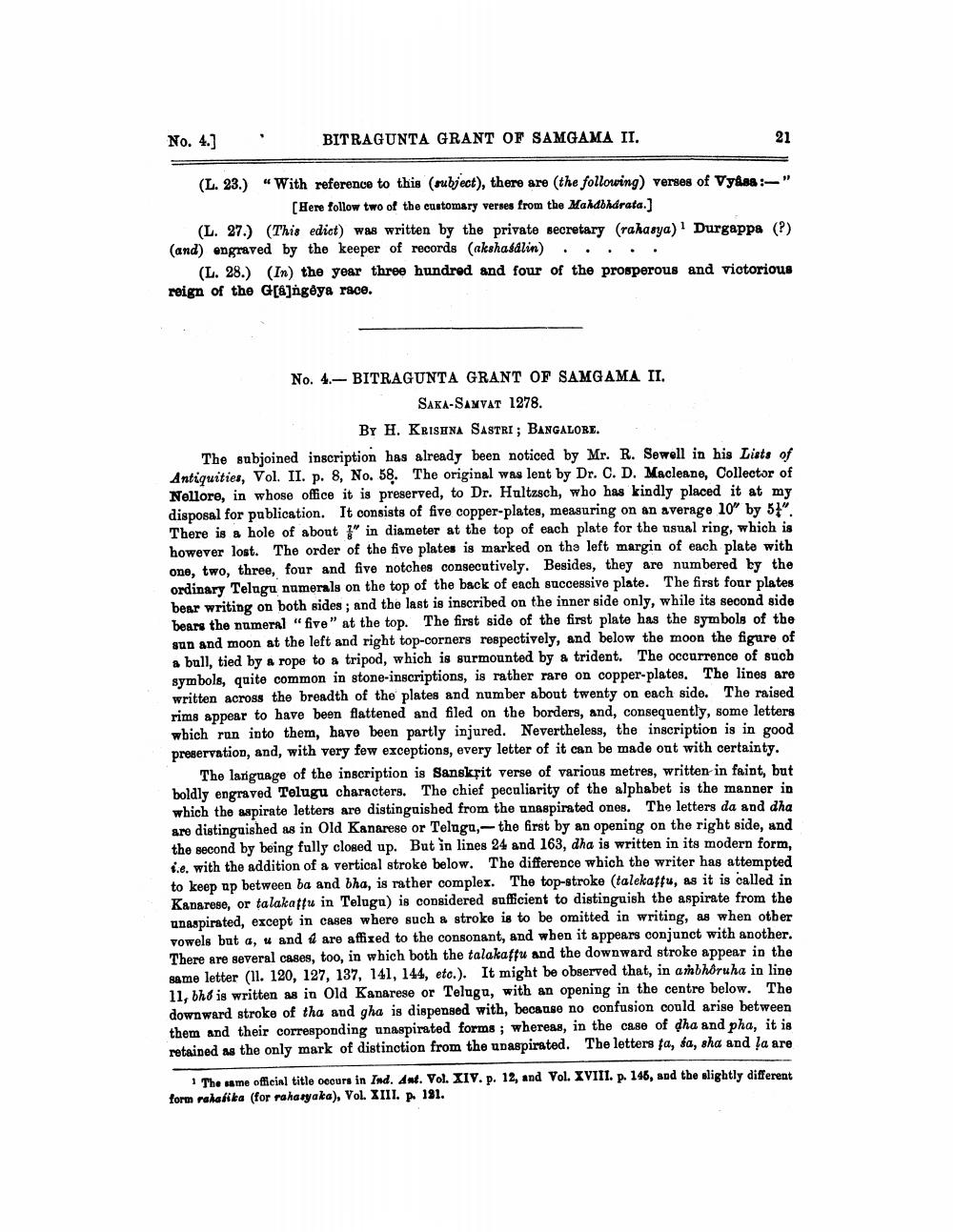________________
No. 4.]
.
BITRAGUNTA GRANT OF SAMGAMA II.
(L. 23.) "With reference to this (subject), there are the following) verses of Vyåsa :-"
(Here follow two of the customary verses from the Mahabharata.) (L. 27.) (This edict) was written by the private secretary (rahasya) Durgappa (?) (and) engraved by the keeper of records (akshasdlin) . . . . .
(L. 28.) (In) the year three hundred and four of the prosperous and victorious reign of the G[&]ngêya race.
No. 4.- BITRAGUNTA GRANT OF SAMGAMA II.
SAKA-SAYYAT 1278.
BY H. KRISHNA SASTRI ; BANGALORE. The subjoined inscription has already been noticed by Mr. R. Sewell in his Lists of Antiquities, Vol. II. p. 8, No. 58. The original was lent by Dr. C. D. Maclenno, Collector of Nellore, in whose office it is preserved, to Dr. Hultzsch, who has kindly placed it at my disposal for publication. It consists of five copper-plates, measuring on an average 10" by 5t". There is a hole of about " in diameter at the top of each plate for the usual ring, which is however lost. The order of the five plates is marked on the left margin of each plate with one, two, three, four and five notches consecutively. Besides, they are numbered by the ordinary Telugu numerals on the top of the back of each successive plate. The first four plates bear writing on both sides; and the last is inscribed on the inner side only, while its second side bears the numeral "five" at the top. The first side of the first plate has the symbols of the sun and moon at the left and right top-corners respectively, and below the moon the figure of a bull, tied by a rope to a tripod, which is surmounted by a trident. The occurrence of such symbols, quite common in stone-inscriptions, is rather rare on copper-plates. The lines are written across the breadth of the plates and number about twenty on each side. The raised rims appear to have been flattened and filed on the borders, and, consequently, some letters wbich run into them, have been partly injured. Nevertheless, the inscription is in good preservation, and, with very few exceptions, every letter of it can be made out with certainty.
The larguage of the inscription is Sanskrit verse of various metres, written in faint, but boldly engraved Telugu characters. The chief peculiarity of the alphabet is the manner in which the aspirate letters are distinguished from the unaspirated ones. The letters da and dha are distinguished as in Old Kanarese or Telugu, - the first by an opening on the right side, and the second by being fully closed up. But in lines 24 and 163, dha is written in its modern form, ie, with the addition of a vertical stroke below. The difference which the writer has attempted to keep up between ba and bha, is rather complex. The top-stroke (talekattu, as it is called in Kanarese, or talakatfu in Teluga) is considered sufficient to distinguish the aspirate from the unaspirated, except in cases where such a stroke is to be omitted in writing, as when other vowels but a, u and i are affixed to the consonant, and when it appears conjunct with another. There are several cases, too, in which both the talakaffu and the downward stroke appear in the same letter (11. 120, 127, 137, 141, 144, etc.). It might be observed that, in arbhóruha in line 11, bhd is written as in Old Kanarese or Telugu, with an opening in the centre below. The downward stroke of tha and gha is dispensed with, because no confusion could arise between them and their corresponding unaspirated forms; whereas, in the case of dha and pha, it is retained as the only mark of distinction from the unaspirated. The letters ta, fa, sha and la are
1 The name official title occurs in Ind. Ant. Vol. XIV. p. 12, and Vol. XVIII. p. 146, and the slightly different form rakafika (for rahasyaka), Vol. XIII. p. 191.




